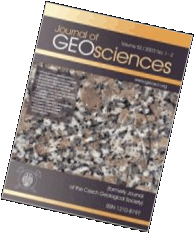Original Paper
Stannite and kesterite from the Peerless pegmatite, Black Hills, South Dakota, USA
Journal of the Czech Geological Society, volume 46 (2001), issue 1-2, 27 - 34
Stannite and kesterite occur as thumb-size nodules along the margins of the quartz core of the Peerless granitic pegmatite near Keystone in the Black Hills of South Dakota. Kesterite is associated with minor tetrahedrite and tennantite; rare chalcopyrite accompanies both stannite and kesterite. In individual nodules, stannite and kesterite are relatively homogeneous in chemical composition, but compositions are highly variable among different nodules. The main variables are Fe and Zn, whereas Cd is present in mere traces. Four samples examined in detail have average compositions of Stn75Kst25, Stn72Kst,sub>28 (zincian stannite) and Stn46Kst54, Stn44Kst56 (ferroan kesterite). Deviations from ideal stoichiometry are largely less than 1 % relative, and well within the limits of analytical error. The Cu:(Fe,Zn, Cd):Sn ratio is rather uniform and very close to 2:1:1, but it slighly favours (Fe,Zn,Cd) as in previously published analyses. The difference in unit-cell dimension 2a-c decreases with increasing (Zn+Cd)/[(Zn+Cd)+(Fe+Mn)], in accord with the data for quenched synthetic phases and some natural minerals. However, 2a of kesterite is not equal to its c. Contents of the cadmian černýite component in the stannite-group minerals from granitic pegmatites are suspected to be only roughly correlated with other fractionation indicators in oxide and silicate minerals.
Webdesign inspired by aTeo. Hosted at the server of the Institute of Petrology and Structural Geology, Charles University, Prague.
ISSN: 1803-1943 (online), 1802-6222 (print)
email: jgeosci(at)jgeosci.org


IF (WoS, 2024): 1.3
5 YEAR IF (WoS, 2024): 1.4
Policy: Open Access
ISSN: 1802-6222
E-ISSN: 1803-1943
 Export to Mendeley
Export to Mendeley